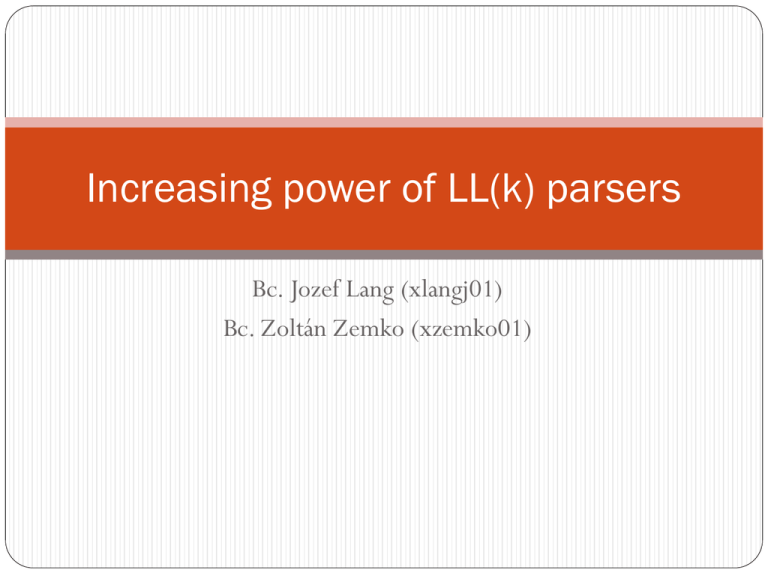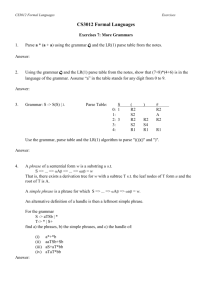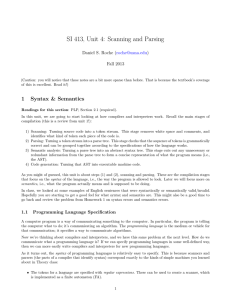Increasing power of LL(k) parsers
advertisement

Increasing power of LL(k) parsers
Bc. Jozef Lang (xlangj01)
Bc. Zoltán Zemko (xzemko01)
Outline
LL(1) parsers
Why increasing the power of LL(k) parsers?
LL(k) parsers
Linear approximate LL(k) parsing
LL-regular parsing
Parse tree grammars
Extended LL(1) grammars
Conclusion
LL(1) parsing
Deterministic top-down parsing
Prediction is made only of one symbol, thus LL(1) is an 1
look-ahead parsing
The starting terminal symbol of every non-terminal symbol
is needed when a parse table is constructed
FIRSTk set -- set of terminals that are at the first k positions
of strings that non-terminal can be derived to
FOLLOW set – set of all terminal symbols that can follow
non-terminal symbol in any sequential form derivable from
S#
LL(1) versus strong-LL(1)
If all entries of the parse table have at most one element then
the grammar is called strong-LL(1)
Every LL(1) grammar is also a strong-LL(1) grammar
When a parse table entry contains more than one entry then
it is a LL(1) conflict
A parser with LL(1) conflict is not deterministic and thus is
less efficient
LL(1) versus strong-LL(1) (2)
LL(1) conflicts can be solved by
Left recursion elimination
Left factoring
Conflict resolvers
Why increasing the power of LL(k)
parsers?
Let’s have a following grammar where idf produces
identifiers:
This fragment defines expression elements like x, sin(0.41),
T[2,3]
First token is common for all expressions, but the second
token distinguish between alternatives
Look ahead of only one token is not enough
It would be handy to increase power of deterministic LL
parsing.
LL(k) parsers
It is sometimes handy to look ahead of k symbols, where
k>1
Need to define FIRSTk sets
Let’s have sequential form x. FIRSTk(x) is a set of terminals
where:
where y is some sequential form
LL(k) parsers (2)
Assume that we have following rule in a grammar G
Grammar G is a LL(k) grammar iff the sets FIRSTk(a1x#k)
… FIRSTk(akx#k) are pairwise disjoint.
Symbol #k represents the number of look-ahead symbols
It is obvious that every LL(k) grammar is a subset of LL(k+1)
grammars, this does not hold vice versa.
LL(k) parsers (3)
Similarly as by LL(1) parsers, producing parse tables for
LL(k) parsers is difficult
FOLLOW set for a LL(k) grammar is defined as an union of
FIRSTk(x#k) for any prediction Ax#k
As by LL(1) parsers, the parse table will be indexed by with a
pair consisting of a non-terminal symbol and string of
terminals with the length equal to k
If a parse table has for every entry at most one element then
the grammar denoted by this parse table is strong-LL(k)
For k > 1 there are grammars that are LL(k) but not strongLL(k)
LL(k) parsers (4)
Strong-LL(k) parsers are only seldom used in practice
Similar effect can be obtained by using conflict resolvers
Linear-approximate LL(k) parsing
Difficult constructing of LL(k) parse tables can be avoided by
a simple trick
In addition to FIRST set, introduce SECOND, THIRD etc set
The size complexity is reduced from O(tk) to k tables of
O(t), where k is the number of sets
Linear-approximate LL(k) grammar is weaker than LL(k)
grammar because it breaks the relationship between tokens
Let’s assume that we have LL(2) grammar that has look ahead
sets of { ab, cd }{ad, cb }
Linear-approximate LL(2) grammar has FIRST set { ac }
and SECOND {bd} – there are not disjoint
LL -regular parsing
LL(k) provides bounded look-ahead
There are grammars where a discriminating token can be
arbitrarily far away
Unbounded look-ahead is needed
Unbounded look-ahead forms its own context-free grammar
Context-free grammar can be approximated by regular
grammar
There is no algorithm to approximate context-free grammar,
but there are several heuristics
Parse tree grammar from LL(1)
A straightforward process
Basic idea is to create new rule for every prediction
The non-terminals are numbered by an increasing global
counter
Then are inserted into prediction stack
New created rules forms parse tree grammar
As far as the parser is deterministic, the parse tree grammar
is obtained instead of parse forest grammar
Parse tree grammar from LL(1) (2)
Extended LL(1) grammars
Some parsers accept Extended LL(1) grammars instead of
ordinary one
To accept Extended LL(1) grammar parser must transform it
to ordinary one without introducing LL(1) conflicts
An advantage of Extended LL(1) grammars is that they allow
a more efficient implementation in recursive descent parsers
Conclusion
LL(1) is very intuitive, makes its steps according to
prediction of one token
There are situations where look-ahead only of one symbol is
not sufficient
The power of LL parsers can be improved by extending the
bounding look-ahead to
a bounded length resulting in LL(k) parsing
a unbounded length resulting in LL – regular parsing
Linear-approximate LL(2) parsing is a convenient and
simplified form of a LL(2) parsing
Thank you for your attention









